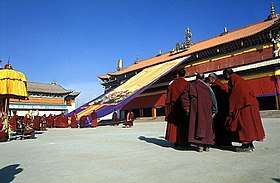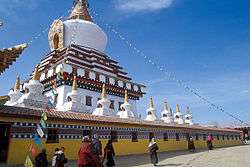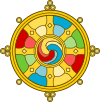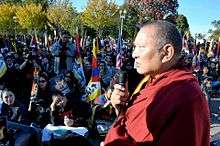Kirti Gompa
Kirti Gompa (Standard Tibetan: ཀིརྟི་དགོན་པ།), is a Tibetan Buddhist monastery founded in 1472 and located in Tibet. As of March 2011, the gompa was said to house 2,500 monks. However, reports indicate its population has declined substantially as a result of a crackdown by authorities.[1]
| Kirti Gompa | |
|---|---|
Tibetan transcription(s) Tibetan: ཀི་རྟི་དགོན་པ། | |
 Kirti Gompa or Gerdeng Monastery. | |
| Religion | |
| Affiliation | Tibetan Buddhism |
| Sect | Gelugpa |
| Leadership | Twelfth Kirti Tsenzhab Rinpoche |
| Location | |
| Location | Ngawa Tibetan and Qiang Autonomous Prefecture, Sichuan Province of China. |
| Country | China |
 Location within Sichuan | |
| Geographic coordinates | 32°54′N 101°42′E |
| Architecture | |
| Founder | Rongpa Chenakpa |
| Date established | 1472 |

| Part of a series on |
| Tibetan Buddhism |
|---|
 |
|
|
|
Practices and attainment |
|
Institutional roles |
|
History and overview |
History
Kirti Gompa was founded in 1472 by Rongpa Chenakpa, a disciple of Tsongkhapa.[2] It was established as a branch of Taktsang Lhamo Kirti Gompa (Nama Ge’erde Si) near the border with Gansu Province in 1693 but has outgrown its mother monastery.
The first Kirti Monastery founded by Kirti Rinpoche was in Gyelrang. These days the two main Kirti Monasteries are in Taktsang Lhamo and Ngawa prefecture, in Sichuan, China. Until the invasion of Tibet by China, the area was part of the historic Tibetan region of Kham. Taktsang Lhamo was destroyed during the Cultural revolution and has now been rebuilt.[3] There are numerous (approximately 30–40) smaller monasteries affiliated with the Kirti Monasteries spread throughout the region.
The Twelfth Kirti Tsenzhab Rinpoche, the 55th lama to head the monastery, now lives in exile and founded a Kirti Monastery in Dharamsala in India in April 1990.[2][4][5]
Ngawa Kirti Gompa
Ngawa Kirti Gompa (sometimes referred to as Ge’erdengsi or Gerdeng Monastery), properly known as Kirti Kalari Gon Tashi Lhundrub, is a Gelugpa monastery on the northwestern edge of Ngawa City, the main city in Ngawa County, within the Ngawa Tibetan and Qiang Autonomous Prefecture in northwestern Sichuan, China. It is located on the Tibetan plateau at an elevation of 3,200 metres (10,499 ft.)
Outside the north wall of the monastery is a towering statue of Shakyamuni Buddha. The imposing Assembly Hall or Tensi Dratsang (Dialectical College) has 120 pillars. It contains an 8-metre (26 ft) statue of Maitreya, flanked by Jowo Shakyamuni and Kirti Lobzang Chungla. There are also several other important buildings including: the Chokhang (Offering Chapel), the Lhabrang or residence of Kirti Rinpoche, the Zhungkhang (Monastic Office), the Gyupa Dratsang (Tantric College), the Menpa Dratsang (Medical College), and the Dukhor Dratsang (Kalacakra College).[6]
Kirti Gompa is also famous for its 30-metre (98-ft) high white chorten known as the Dudul Chorten which has numerous chapels on the various floors respectively dedicated to Shakyamuni Buddha, Mahakarunika, and the Three Deities of Longevity, Tsongkhapa and Sitatapatra.[2] It the largest Tibetan Monastery in Ngawa town.
Incidents
The monastery is the center of the wave of Tibetan self-immolation. It is under close supervision by the People's Armed Police.[7] The monks at Kirti monastery have long been restive, engaging in political protests,[8] A self-immolation of a monk occurred in March 2011, for which several other colluding monks were arrested.[9] The Free Tibet Campaign (FTC) says that the monastery's population declined from 2,500 to 600 in March 2011 because of a crackdown on political and other illegal activities.[1] In October, a series of monks under the age of 24 attempted copycat suicides by self-immolation at Kirti Monastery. Police are investigating their motives: the International Campaign for Tibet alleges that the monks shouted anti-government slogans while setting themselves on fire, but independent media did not have access to the area.[9]
The ITC and FTC say that nine monks and nuns in the area have self-immolated in 2011, and that police and military surveillance has increased as a result.[10] Tibet expert Dibyesh Anand said that the peer pressure of fellow monks to prove their own "patriotism" was partly to blame, as well as the desperation of disciplined monks who had only religious and no vocational training.[11] A spokesperson for the Tibetan government-in-exile told the BBC that Tibetan Buddhism did not condone such violence,[9] but the 14th Dalai Lama led a prayer service to honor the suicided monks. A spokeswoman for the Chinese foreign ministry accused the Dalai Lama of thus "glorifying" and "inciting" more suicides.[12]
Taksang Lhamo Kirti Gompa
The Taksang Lhamo Kirti Gompa is located in the Zorge district, Sichuan Province. It has approximately 700 monks in residence.
Kirti Jepa Datsang Gompa

Kirti Jepa Datsang Gompa is located in Dharamsala, India. It was built in 1992 to house Tibetan exile monks from Tibet. Today, the monks number approximately 200 and includes Kirti Rinpoche.
Darjeeling Kirti Gompa
This is a small Kirti Monastery in Darjeeling, India with approximately 40 monks.
Ceremonies
New Year (Losar) Festivals in the first Lunar month include masked dances and the display of a large thangka.[13] As part of the Monlam Festival there is a ceremony for "Sunning the Buddha", and a big thangka of Tsongkhapa is displayed on a huge Thangka Wall behind the monastery. This Khakhl Sham (Appliqué Tangkha Show) was first held in 1468 by the First Dalai Lama, Gendun Drub (1391–1474). Originally the thangka was smaller, but after the 4th Panchen Lama, Lobzang Chokyi Gyeltsen (1567–1662), the size was increased more and more until it reached its present dimensions.
References
- "China hit by new Tibet self-immolation protest". The Inquirer. Manila: Inquirer Interactive, Inc. 16 October 2011.
- Dorje, Gyurme (2009). Footprint Tibet Handbook. Footprint Books. p. 779. ISBN 978-1-906098-32-2.
- Marc Moniez, Christian Deweirdt, Monique Masse, Le Tibet, 1991, ISBN 2-907629-46-8, p. 513
- Kanamaru, Atsushi; Osada, Yukiyasu; Allwright, Gavin (2004). Mapping the Tibetan World. reprint. Reno, Nevada: Kotan Publishing. p. 227. ISBN 0-9701716-0-9.
- Kirti Monastery
- Dorje, Gyurme (2009). Footprint Tibet Handbook. Footprint Books. pp. 779–780. ISBN 978-1-906098-32-2.
- Edward Wong (2 June 2012). "In Occupied Tibetan Monastery, a Reason for Fiery Deaths". The New York Times. Retrieved 3 June 2012.
- "2500 Monks of Tibet Ngaba Monastery Face Food Shortage". The Tibet Post International. 11 April 2011.
- Bristow, Michael (4 October 2011). "Self-immlation 'trend' at restive Tibetan monastery". BBC News. BBC.
- "Tibetan Nun Sets Self on Fire". The Edmonton Journal. AFP. 19 October 2011.
- Demick, Barbara (23 October 2011). "In China, self-immolations add radical bent to Tibetan protests". Los Angeles Times. Retrieved 23 October 2011.
- "China calls Dalai Lama's stance on monk immolations an incitement to terrorism". Washington Post. Associated Press. 19 October 2011. Retrieved 23 October 2011.
- Dorje, Gyurme (2009). Footprint Tibet Handbook. Footprint Books. p. 780. ISBN 978-1-906098-32-2.
| Wikimedia Commons has media related to Kirti Gompa Monastery. |
External links
- China Tour – Gerdeng Temple
- 7 photos at Super Stock